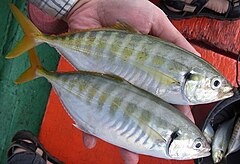Atule
| Yellowtail scad | |
|---|---|
 |
|
| Scientific classification | |
| Kingdom: | Animalia |
| Phylum: | Chordata |
| Class: | Actinopterygii |
| Order: | Perciformes |
| Suborder: | Percoidei |
| Superfamily: | Percoidea |
| Family: | Carangidae |
| Genus: |
Atule D. S. Jordan & E. K. Jordan, 1922 |
| Species: | A. mate |
| Binomial name | |
|
Atule mate (G. Cuvier, 1833) |
|
 |
|
| Approximate range of the yellowtail scad | |
| Synonyms | |
|
|
The yellowtail scad (Atule mate) (also known as the northern yellowtail scad, one-finlet scad, deep trevally and omaka), is an abundant species of small inshore marine fish of the jack family, Carangidae. The species is widespread in the Indo-Pacific region from east Africa in the west to Hawaii in the east, extending north to Japan and south to Australia. The yellowtail scad is the only member of the monotypic genus Atule and is distinguished from similar species by a well-developed adipose eyelid and finlet-like extensions of the last rays of the dorsal and anal fins. It inhabits coastal areas such as bays and coral reefs, preying on small fishes and crustaceans. Spawning has been well studied in Hawaii, where fish enter bays to spawn, releasing up to 161,000 eggs each between March and October. The yellowtail scad is an important component of fisheries throughout its range, taken by a number of netting and hook-and-line methods. It is a prized food fish in some regions and is cooked or preserved by a variety of methods.
The yellowtail scad is the only member of the monotypic genus Atule, one of 30 genera in the jack and horse mackerel family Carangidae. The Carangidae are perciform fish in the suborder Percoidei.
...
Wikipedia
